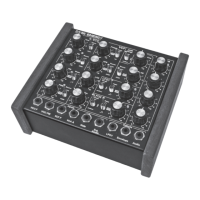4. Basics of Soundgeneration
Incaseanaloguesynthesizersorsynthesizersingeneralarenewtoyou,pleasereadthissection.Youmay
learnsomebasicsaboutanalogue/subtractivesoundsynthesisthatwillhelpyoutofullyunderstandDark
Energy’s little secrets.
Soundis,verygenerallyspoken,achangeofairpressure.Ifthesechang-
eshappencontinouslyandwithacertainfrequency,theycanbecomean
audiblenoiseortone.FrequencyismeasuredinHertz(Hz).Thehuman
earperceptsfrequenciesapprox.between20Hzand20.000Hz.The
frequencyofanaudiblesignaldetermintesit’smusicalpitch.
Anotherbasicparameterthatisperceptedbyourearsisloudness resp.
thelevelofanaudiblesignal.Loudtonesornoisesmovemoreairthan
weakones.Thus,the“size”ofthesignaliscalledamplitudeandismea-
suredinDezibel(dB).
Thethirdimportandparametertodeneasoundisthetimbre.Theisnospecialdenition,itisusually
describedwithassociativeterms,suchassharp,dull,bright,dark,thinorrich.
Thetimbreisdeterminedbythesocalledovertonecontentofthesound.Ingeneral,brightsoundscontain
moreovertones,dullsoundslesser.
Aswesee,the“rawmaterial”ofasoundisdenedbythethreeparametersfrequencyorpitch,loudnessor
levelandtimbreresp.overtonecontent.
Oscillators and Waveforms
Withanalogsynthesizersthetonal“rawmaterial”isproducedbyvoltage-controlledoscillators(VCOs).Nor-
mally,aVCOprovidesseveralwaveforms.Standardwaveformsarepulse,sawtoothandtriangle.These
aremostusefulinsoundgenaration,sincetheyofferarichbutdifferentovertonecontentandthereforthey
soundverydifferentfromeachother.ThusDarkEnergyusesthem.Lessusedwaveforms(sine,spaced
sawtooth,graphicallyeditablewaveforms)arenotdealtwithhere.
Assaidabove,thewaveformsdifferintheirovertonespectrum,i.e.theycontaindifferentharmonics.An
overtoneiscalledharmonicifitsfrequencyisanintegermultiple(2,3,4,...)ofthebasetonefrequency.
A sawtooth wavecontainsallharmonicswithdescending
amplitudes.

